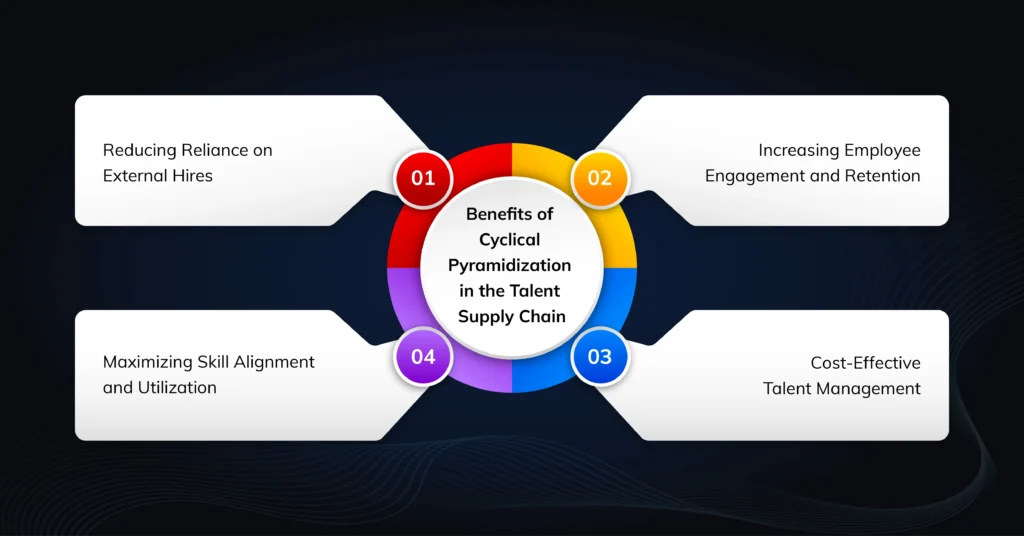Organizations today face mounting pressure to fill critical roles quickly, control talent costs, and remain agile in an evolving skills economy. Traditional workforce models, which rely heavily on external hiring and rigid job structures, are proving inadequate. The solution lies in autonomous cyclical pyramidization—a dynamic talent management approach that continuously moves, reskills, and redeploys internal employees to meet evolving business demands.
Cyclical pyramidization transforms the talent supply chain by reducing the need for external hires, maximizing internal mobility, and ensuring precise skill alignment across all organizational levels. By embracing this approach, companies can reduce recruitment costs, optimize talent utilization, and maintain an agile and future-ready workforce.
This blog delves into how cyclical pyramidization works, its benefits for talent supply chains, and how Spire.AI’s Domain-Intelligent AI enables organizations to automate and optimize this process.
Challenges of Traditional Workforce Structures
Many organizations still rely on outdated workforce models characterized by hierarchical and fixed roles. These structures not only stifle innovation but also create bottlenecks that prevent swift responses to market shifts. Furthermore, the growing trend of remote work and the globalization of talent necessitate a more adaptive approach to talent management. By embracing cyclical pyramidization, organizations can dismantle silos and foster collaboration across departments, cultivating a more innovative and engaged workforce.
The Imperative for Dynamic Workforce Models
The modern business landscape requires agility and responsiveness. Organizations that cling to static workforce models often find themselves ill-equipped to navigate the rapid changes brought about by globalization and technological advancements. Skills shortages, increased operational costs, and the challenge of attracting top talent highlight the pressing need for a more dynamic approach to workforce management. Autonomous cyclical pyramidization transforms the talent supply chain, allowing for the fluid movement of employees across roles in real time.
What is Cyclical Pyramidization?
Cyclical pyramidization is a dynamic talent management model that blends the benefits of hierarchical and flat organizational structures. Unlike traditional models, where employees remain locked into specific roles, cyclical pyramidization emphasizes lateral and vertical movement within the organization. Employees are continuously realigned with roles that match their evolving skill sets, business needs, and career aspirations.
Cyclical pyramidization is a dynamic talent management model that blends the benefits of hierarchical and flat organizational structures. Unlike traditional models, where employees remain locked into specific roles, cyclical pyramidization emphasizes lateral and vertical movement within the organization.
Cyclical pyramidization is a dynamic talent management model that blends the benefits of hierarchical and flat organizational structures. Unlike traditional models, where employees remain locked into specific roles, cyclical pyramidization emphasizes lateral and vertical movement within the organization.
This model works by breaking down organizational silos and ensuring that talent moves laterally or vertically based on their expertise and strengths. Whether through upskilling, reskilling, or redeployment, cyclical pyramidization helps organizations meet shifting business needs while keeping employees engaged and challenged.
Key Elements of Cyclical Pyramidization
1. Employee Empowerment
Empowering employees to take charge of their career paths fosters greater engagement and accountability. Organizations that provide the tools and resources for self-directed growth cultivate a more motivated and capable workforce.
2. Continuous Skill Development
Investing in ongoing training and development programs that align with both employee aspirations and business needs is essential. This commitment to upskilling not only enhances employee capabilities but also ensures that the organization remains competitive in a fast-paced environment.
3. Fluid Talent Movement
By facilitating rapid reassignment of employees to roles that match their skills and career goals, cyclical pyramidization ensures that organizations can respond to changing business needs while maintaining high levels of employee satisfaction and retention.
Benefits of Cyclical Pyramidization in the Talent Supply Chain
1. Reducing Reliance on External Hires
One of the most significant benefits of cyclical pyramidization is its ability to reduce an organization’s dependency on external recruitment. Hiring externally is time-consuming and costly, with expenses tied to job postings, interviews, onboarding, and training. Moreover, external hires often take longer to reach total productivity, increasing the risks of skill mismatches and organizational disruptions.
Cyclical pyramidization eliminates these inefficiencies by optimizing internal mobility. Instead of turning to external candidates, organizations can redeploy existing employees into new roles that match their current skills or reskill them for upcoming demands. This approach not only lowers recruitment costs but also minimizes the time-to-productivity, as internally redeployed employees are already familiar with the company’s culture and processes.
2. Maximizing Skill Alignment and Utilization
Skill alignment is critical for maintaining operational efficiency. However, in traditional models, employees are often locked into roles that don’t match their evolving skill sets. This leads to underutilization of talent, low engagement, and increased turnover.
Cyclical pyramidization addresses this by ensuring that employees are always aligned with roles that best use their skills. As business needs change, employees can be reskilled or redeployed into roles where their expertise will have the most significant impact. This not only maximizes the utilization of available talent but also ensures that employees remain engaged and motivated, as they can see clear paths for career advancement.
3. Increasing Employee Engagement and Retention
Employee engagement is essential for any organization’s success. Cyclical pyramidization creates a talent ecosystem where employees are continuously given opportunities to grow, develop new skills, and take on new challenges. This sense of continuous progression increases job satisfaction and reduces turnover, as employees feel they are making tangible progress in their careers.
By fostering a culture of growth and opportunity, organizations can keep top talent engaged and invested in the company’s future. The dynamic nature of cyclical pyramidization ensures that employees see multiple pathways for advancement, whether through lateral moves into new departments or vertical promotions into leadership roles.
4. Cost-Effective Talent Management
While external hiring plays an important role, cyclical pyramidization allows organizations to balance external recruitment with a stronger focus on internal mobility. By investing in upskilling and reskilling programs, companies can fill roles more efficiently using existing talent, ensuring a quicker response to business needs and optimal resource utilization.
Additionally, cyclical pyramidization ensures that talent is deployed where it can have the most significant impact, reducing redundancy and optimizing workforce productivity. This cost-effective approach keeps operating costs low while ensuring the organization remains flexible and responsive to changing business needs.
Spire.AI: The Engine Behind Autonomous Cyclical Pyramidization
While cyclical pyramidization is powerful, achieving its full potential requires the right technology. Spire.AI enables organizations to implement autonomous cyclical pyramidization by providing advanced, Domain-Intelligent AI-driven solutions that automate the entire talent management process—from skill mapping to redeployment.
1. Large Graph Model (LGM) for Skills: Precision in Real-Time
Spire.AI’s Large Graph Model (LGM) for Skills is a groundbreaking framework that maps the intricate relationships between skills, roles, and industries. With over 10.2 million interconnected skill nodes across 26+ industries, Spire.AI’s LGM for Skills continuously updates to reflect the evolving needs of the business.e business.
With over 10.2 million interconnected skill nodes across 26+ industries, Spire.AI’s LGM for Skills continuously updates to reflect the evolving needs of the business.
For example, if a new project requires expertise in cybersecurity, Spire.AI’s LGM for Skills can instantly identify employees with adjacent skills—such as IT risk management—and recommend them for upskilling or redeployment. This real-time talent optimization reduces reliance on external hiring and ensures that organizations can rapidly adapt to changing business conditions.
2. Automating Skill Mapping and Gap Analysis
One key challenge in talent management is manually assessing skills and identifying gaps. Spire.AI eliminates this challenge by automating skill mapping and gap analysis, providing a real-time view of the organization’s skill landscape. Spire.AI can also forecast future skill needs through predictive analytics, allowing organizations to prepare their workforce through targeted training and development proactively.
Spire.AI automates skill mapping and gap analysis, providing a real-time view of the organization’s skill landscape.
This ensures that no skill gaps catch the organization by surprise. Whether preparing for a new product launch or adapting to industry trends, Spire.AI provides the insights needed to align the workforce with strategic goals.
3. The Talent Control Room: Centralized Workforce Intelligence
Spire.AI’s Talent Control Room offers a real-time, centralized platform for managing internal talent. This Domain AI-driven dashboard provides business leaders with actionable insights into talent supply and demand, allowing them to make data-driven decisions about skill redeployment, workforce planning, and reskilling initiatives.
For instance, if a department is experiencing a talent surplus, the Talent Control Room can quickly identify employees who can be redeployed to other business areas, ensuring maximum talent utilization. This autonomous system reduces bench time and eliminates the inefficiencies associated with manual workforce planning.
4. Cross-Pollination of Across Supply & Demand
Spire.AI’s multi-algorithm cross-pollination engine ensures precise matching of open roles with internal talent by continuously analyzing skills, experiences, and employee availability across the organization. This system automatically matches open roles with the most suitable internal candidates, ensuring that employees with the right capabilities are identified and redeployed quickly. This engine has a match accuracy of 98.5%.
This system automatically matches open roles with the most suitable internal candidates, ensuring that employees with the right capabilities are identified and deployed quickly. This engine has a match accuracy of 98.5%.
This process not only helps in filling roles faster but also increases internal mobility, offering employees new opportunities for career growth. For instance, when a new project or demand arises, Spire.AI can instantly identify internal talent that aligns with the project requirements, using factors like adjacent skills, past experiences, and current availability. This targeted redeployment enables businesses to identify and mobilize employees from within and avoid the lengthy external hiring process, helping maintain momentum on key projects.
By optimizing the matching of open roles with internal talent, organizations can reduce time-to-fill, avoid the costs and delays associated with external recruitment, and foster a stronger sense of employee engagement by providing continuous growth opportunities. This internal-first approach ensures that external hiring becomes a strategic choice, used when necessary, rather than the default solution for filling roles.
5. Cost Savings and Efficiency Gains
By automating skill mapping, gap analysis, and internal mobility, Spire.AI helps organizations significantly reduce their talent management costs. External hiring is minimized, and employees are continuously realigned with roles that best match their skills, resulting in up to 70% lower external hiring costs for some clients.
Additionally, the platform’s pyramid optimization feature ensures that talent is deployed efficiently, with a focus on cost-effectiveness. Spire.AI data-driven recommendations optimize the mix of entry-level, mid-level, and senior talent, ensuring the organization operates with maximum margin.
Conclusion
Autonomous cyclical pyramidization is a transformative approach to talent management that prioritizes internal mobility and proactive workforce planning. By leveraging Spire.AI’s advanced technologies, organizations can automate this process, optimizing talent utilization while reducing hiring costs. In an age where adaptability is crucial, embracing cyclical pyramidization enables businesses to respond swiftly to shifting demands, securing the right talent at the right time.
As organizations navigate the complexities of the modern workforce, adopting innovative approaches like cyclical pyramidization is essential. By fostering a culture of continuous learning and development, businesses can unlock the full potential of their talent, driving success in an increasingly competitive landscape. With Spire.AI as a strategic partner, organizations can transform their talent supply chains and position themselves for sustainable growth in the future.







